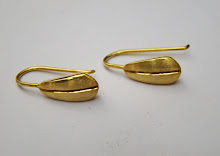Labradorite is an iridescent gemstone which displays a fascinating “schiller” or iridescence when viewed from different angles. It’s a member of the feldspar group of gemstones, my favourite as these gemstones display almost a rainbow of colours and often look as though they have an internal light source!
Labradorite has a background colour of smoky grey, but when light strikes the stone in a particular direction it displays striking colour reflections. Most typically these metallic flashes are blue and green but more rarely yellow, orange and even red can be seen, as in the pendant in the photo.
We bought this stone several years ago from a gem dealer and we were reluctant to set it as once it was on the shop floor we knew it would be gone rapidly. It took less than a week! Labradorite of this size and spectacular colour display are so hard to come by that I find it difficult to let them go! This effect is so unique to labradorite that it is referred to as labradorescence.
Labradorite is usually cut en cabochon or in flat slabs in order to best display the iridescence. Labradorite was named after the Labrador Peninsula in eastern Canada where it was first found around 1770. Deposits have also been found in Australia, Finland, Madagascar, India, Mexico and the Adirondack Mountains There is a Canadian Eskimo legend that claims that the Northern Lights were once trapped in the rocks along the coast of Labrador where an Eskimo warrior saw them and smashed the rocks with his spear to release the lights. He managed to free a lot of the lights but some were still caught in the rocks which now form the gemstone Labradorite. You could almost believe it when you first see the flash of colour for yourself!
Monday, September 12, 2011
Subscribe to:
Comments (Atom)




